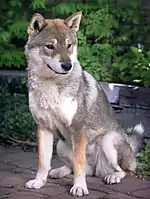| Shikoku | |||||||||||||
|---|---|---|---|---|---|---|---|---|---|---|---|---|---|
 | |||||||||||||
| Other names | Kochi-ken[1] | ||||||||||||
| Origin | Japan | ||||||||||||
| |||||||||||||
| Dog (domestic dog) | |||||||||||||
The Shikoku Inu (四国犬, Shikoku-ken) or Kōchi-ken (高知犬)[1] is a Japanese breed of dog from Shikoku island.[2] It was designated by Japan as a culturally important national treasure in 1937.[3]
Comparison to other Japanese breeds
The Shikoku is one of the six native Japanese breeds, it is intermediate in size between the large Akita Inu and the small Shiba Inu; all are within the Spitz family of dogs.
A study of the 1930s carried out by the Japanese cynologist[4] Haruo Isogai classified all native Japanese dog breeds into three categories: large-, medium-, and small-sized. The Shikoku belongs to the Shika-inus, the medium-sized dogs. Other medium-sized dogs are the Kai Ken, the Ainu Ken and the Kishu Inu. They are all very similar with overlapping colors and only minor differences in size and morphology.
It also served as the partial ancestor to the Tosa after it was crossed with European breeds such as the Great Dane, Old English Bulldog, English Mastiff, St. Bernard (dog) and others.
Characteristics and temperament


The Shikoku stands 18.1–21.6 inches (46–55 cm) tall at the withers and comes in sesame (red with black tipping), black and tan, or red. Sesame coats are found in a range of saturation and black pigment- typically designated as red sesame, sesame, or black sesame. In addition, there is a cream colored coat that is rarely seen as it is not an accepted color in the breed. In all of these colors there is usually a mixture of white found around the underside of the body, near the eyes, snout, and legs called "urajiro". The Shikoku tends to shed its coat at least one to two times a year. The dog has a fairly thick coat with pointed ears and a curved tail. The body conformation is typically of the spitz-type: the square body, the wedge-shaped head, the prick triangular ears, and thick curled tail.
The Shikoku Inu ranges 14–23 kg (31–51 lb) (male; approximately 20 inches tall; female; approximately 18.5 inches tall). This dog would be considered medium-sized.
Varieties
Out of the reconstruction effort, three distinct lines of the Shikoku were developed: the Awa, the Hongawa and the Hata all named after the area they originated from within the Kochi prefecture. More recently the distinction between these lines has been blurred as remote areas where the dogs originated became easier to access and lines were cross-bred. The modern Shikoku is thought to descend mainly from the Hongawa and Hata lines as the Awa line essentially disappeared as a result of the hardships caused by World War II and a lack of quality specimens due to cross breeding with outside dogs.[5]
See also
References
- 1 2 FCI Breed Standard
- ↑ FCI Breed standard
- ↑ JKC breed standard
- ↑ Haruo Isogai was a dog breeder who worked up a classification system for Japanese dogs based on appearance, as a nationalist response to the adoption by dog enthusiasts in Japan of European breeds in the 1930s. ( in Dutch) ("Zaras-Traumwelten - Russischer Traber". Archived from the original on 2009-04-06. Retrieved 2008-04-12. in German) There is no evidence that he had any relevant scientific training or even that he ever called himself a "cynologist".
- ↑ "North American Shikoku Club » the North American Shikoku Ken Club (NASC) | Breed History".